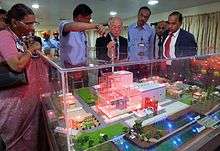Tarapur Atomic Power Station
| Tarapur Atomic Power Station | |
|---|---|
 Model of the Tarapur Atomic Power Station | |
 Location of Tarapur Atomic Power Station in Maharashtra | |
| Country | India |
| Location | Tarapur, Palghar district, Maharashtra |
| Coordinates | 19°49′44.33″N 72°39′40.34″E / 19.8289806°N 72.6612056°ECoordinates: 19°49′44.33″N 72°39′40.34″E / 19.8289806°N 72.6612056°E |
| Status | Operational |
| Construction began | 1962 |
| Commission date | 28 October 1969 |
| Operator(s) | Nuclear Power Corporation of India |
| Power generation | |
| Units operational |
2 × 160 MW 2 × 540 MW |
| Average generation | 4,829 GWh |
Tarapur Atomic Power Station (T.A.P.S.) is located in Tarapur, Maharashtra, India. It was initially constructed with two boiling water reactor (BWR) units of 210 MWe each initially by Bechtel and GE under the 1963 123 Agreement between India, the United States, and the International Atomic Energy Agency (IAEA). The capacity of units 1 and 2 was reduced to 160 MWe later on due to technical difficulties. Units 1 and 2 were brought online for commercial operation on 28 October 1969.[1] These were the first of their kind in Asia. More recently, an additional two pressurised heavy water reactor (PHWR) units of 540 MW each were constructed by L & T and Gammon India, seven months ahead of schedule and well within the original cost estimates. Unit 3 was brought online for commercial operation on 18 August 2006, and unit 4 on 12 September 2005.[1]
History
With a total capacity of 1400 MW, Tarapur is the largest nuclear power station in India. The facility is operated by the NPCIL (Nuclear Power Corporation of India).
The personnel operating the power plant live in a residential complex called T. A. P. S. colony, 19°48′58″N 72°44′35″E / 19.816°N 72.743°E which is a fifteen-minute drive from Boisar, the nearest railway station. The residential complex was also constructed by Bechtel to house both Indian and American employees. Due to this, the residential complex had a very American small-town look, with neat sidewalks, spacious houses, a club with tennis courts, swimming pool, a commissary etc. While the original American residents have long gone, the colony continues to thrive.
The residential colony now features 3 central schools run under Atomic Energy Education Society (AEES). The local beach at Chinchani is approximately 7 kilometres (4.3 mi) from the colony. Its by Mudassir
Safety concerns
The Boiling water reactors (BWRs) at Tarapur 1 and 2 units are similar to the reactors involved in the Fukushima Daiichi nuclear disaster.[2] The reactors' age and old design have raised safety concerns and according one local leader, the two reactors have already been in operation for 16 years more than their design lives.[2] The reactors were originally designed for 40 years at full capacity i.e. 210 MWe.
In 2007, Atomic Energy Regulatory Board (AERB) evaluated seismic safety features at Tarapur 1 and 2 and reported many shortfalls, following which NPCIL installed seismic sensors.[3] In 2011, AERB formed a 10-member committee, consisting of experts from Indian Institutes of Technology (IIT) and India Meteorological Department (IMD), to assess the vulnerability of the Tarapur to earthquakes and tsunamis.[4] A. Gopalakrishnan, former director of AERB, said that Tarapur 1 and 2 reactors are much older than the reactors involved in the Fukushima nuclear accident and argued that they should be immediately decommissioned.[5]
See also
- Nuclear power in India
- Template:India nuke plant map
- List of Indian Nuclear Reactors
References
- 1 2 "Plants Under Operation - Nuclear Power Corporation of India Limited". Retrieved 20 April 2015.
- 1 2 "Fears rise in India of Fukushima-style nuclear disaster". BBC News. Retrieved 20 April 2015.
- ↑ "Atomic Energy Regulatory Board not quite subatomic". timesofindia-economictimes. Retrieved 20 April 2015.
- ↑ "AERB committee forms sub-group to carry Tarapur plant audit". Retrieved 20 April 2015.
- ↑ Doubts raised on Tarapur nuclear plant’s safety